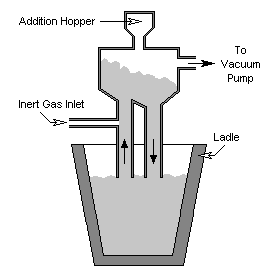Ladle Metallurgy: Equipment
|
Principle of operation of the R-H process |
Equipment
Combustion Technology
Energy Consumption
Process Description
R&D Trends
There are a wide variety of equipment types under this broad classification. They share some or all of the following features: vacuum treatment, argon injection, injection of metals or other materials that have a scavenging action on impurities, reheating or other means of temperature control.Stream Degassing Processes:
Ladle-to-Mold Degassing
Ladle to mold degassing is used for casting of large forging ingots inside a vacuum enclosure. In this and other steam degassing techniques, superheat in the primary steelmaking process is the means of temperature control for the process.
Ladle-to-Ladle Degassing
Ladle-to-ladle degassing is used to remove hydrogen, oxygen, and carbon which reacts with the oxygen when the vacuum is applied.
Tap Degassing
In tap degassing, the primary steelmaking tap is poured into a tundish while a sealed ladle is itself evacuated to initiate the process.
Recirculation Degassing:
D-H Process
In the D-H Process, an evacuated vessel is lowered into the ladle and molten metal is drawn up through a snorkel tube where it is degassed and alloying and conditioning elements are added. In all of the recirculation processes, the vacuum chamber is preheated using either gas burners or an electric heating rod.
R-H Process
The R-H Process employs two legs on the vacuum chamber that are lowered into the melt. Argon is injected in one leg causing a vigorous boiling and mixing action.
R-H-OB Process
The R-H-OB Process is a variation on the R-H Process in that oxygen is also added for greater decarburization.
Vacuum Ladle Degassing:
Induction Stirring
In induction stirring, superheated steel is poured inside a preheated ladle and placed within a special vacuum chamber. Large electric coils provide induce induction currents and stirring of the melt that aids in degassing. Alloying elements are added after the degassing stage.
Vacuum-Oxygen Decarburization
The Vacuum-Oxygen Decarburization process is used in the making of stainless steels. Inside the vacuum chamber, an oxygen lance is blown on top of the melt while argon is bubbled up from the bottom. Desulfurizing slag treatments can be added after the degassing.
Vacuum Degassing with Supplemental Reheating:
Gas Stirring Arc Reheating
The gas stirring arc reheating furnace uses electric arc heating to provide heat to the ladle during treatment. Ladle refining furnaces can also use induction heating, and R&D is underway on gas heating. The addition of heat allows better control of temperature variables and greater addition of alloying materials.
Vacuum Arc Remelting
In the vacuum arc remelting process, a steel electrode of the basic composition desired in the final product is used to strike an arc inside an ingot mold inside a vacuum vessel. The steel electrode melts and resolidifies in the mold in a very dense crystalline pattern with very low gas content. The process is expensive and only used for specialty products.
Modified Vacuum Induction
In Modified Vacuum Induction (called the Therm-I-Vac process) the unit provides for degassing, alloying, ingot casting, all under vacuum. Induction heating provides heat during the process.
Non-vacuum Ladle or Vessel Refining
Capped Argon Bubbling (CAB)
In the Capped Argon Bubbling (CAB) system, argon is bubbled through a conventional covered ladle covered with a synthetic slag. The slag is designed to absorb undesireable nonmetallic compounds and protect the melt from oxidization. The argon bubbling promotes rapid mixing. A closely related process – CAS for Composition Adjustment by Sealed Argon Bubbling – uses a snorkel tube to introduce alloying elements without contacting the slag.
Argon-Oxygen Decarburizing (AOD)
The Argon-Oyxgen Decarburizing (AOD) process is an economical way to produce stainless steels. During the processing, a mixture of argon and oxygen is blown into the melt through a tuyere in the bottom of the vessel. The mixture is gradually adjusted from a 3:1 oxygen/argon mixture to a final ratio of 1:3. The process produces metal with very low carbon (0.03%), hydrogen, and nitrogen.
Electro-slag remelting
Similar to the VAR process, Electro-slag remelting produces an ingot of very high quality by melting a feed metal electrode directly into an ingot mold. In this process, a slag pool instead of a vacuum is used to isolate the melt from the atmosphere.
Ladle Injection
Ladle injection is used for adding rare-earth metals (REM) to molten steel. REM is used to change the morphology of sulfides and other non-metallics in the melt.

